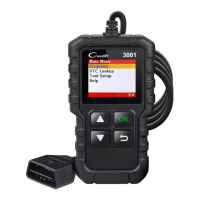LAUNCH
3001
User’s Manual
15
9. NOx Adsorber Monitor
NOx aftertreatment is based on a catalytic converter support that has been coated
with a special washcoat containing zeolites. NOx Aftertreatment is designed to
reduce oxides of nitrogen emitted in the exhaust stream. The zeolite acts as a
molecular “sponge” to trap the NO and NO2 molecules in the exhaust stream. In
some implementations, injection of a reactant before the aftertreatment purges it.
NO2 in particular is unstable, and will join with hydrocarbons to produce H2O and
N2. The NOx Aftertreatment Monitor monitors the function of the NOx
aftertreatment to ensure that tailpipe emissions remain within acceptable limits.
The NOx Aftertreatment Monitor is supported by “compression ignition” vehicles
only. The NOx Aftertreatment Monitor is a “Two-Trip” Monitor. If a fault is found on
the first trip, the computer temporarily saves the fault in its memory as a Pending
Code. The computer does not command the MIL on at this time. If the fault is
sensed again on the second trip, the computer commands the MIL “On,” and
saves the code in its long-term memory.
10. Boost Pressure System Monitor
The boost pressure system serves to increase the pressure produced inside the
intake manifold to a level greater than atmospheric pressure. This increase in
pressure helps to ensure compete combustion of the air-fuel mixture. The Boost
Pressure System Monitor checks for component integrity and system operation,
and tests for faults in the system. The computer runs this Monitor once per trip.
The Boost Pressure System Monitor is supported by “compression ignition”
vehicles only. The Boost Pressure System Monitor is a “Two-Trip” Monitor. If a
fault is found on the first trip, the computer temporarily saves the fault in its
memory as a Pending Code. The computer does not command the MIL on at this
time. If the fault is sensed again on the second trip, the computer commands the
MIL “On,” and saves the code in its long-term memory.
11. Exhaust Gas Sensor Monitor
The exhaust gas sensor is used by a number of systems/monitors to determine
the content of the exhaust stream. The computer checks for component integrity,
system operation, and tests for faults in the system, as well as feedback faults that
may affect other emission control systems.
The Exhaust Gas Sensor Monitor is supported by “compression ignition” vehicles
only. The Exhaust Gas Sensor Monitor is a “Two-Trip” Monitor. If a fault is found
on the first trip, the computer temporarily saves the fault in its memory as a
Pending Code. The computer does not command the MIL on at this time. If the
fault is sensed again on the second trip, the computer commands the MIL “On,”

